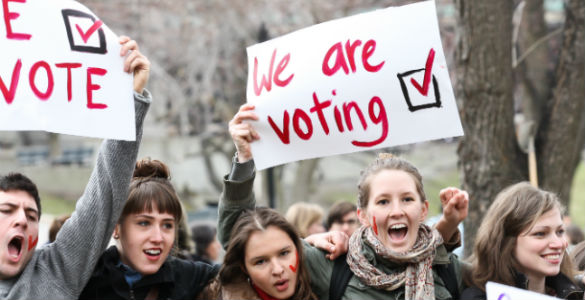Will the ‘youthquake’ shake up the 2018 local elections?
Youth engagement was heralded by some as a key factor in the 2017 UK general election result but what impact could it have in the 2018 local elections? Erica Belcher argues that this enthusiasm may not necessarily translate to the local level, but it’s more important than ever for young people to engage in local politics.

Student youth vote campaign. Picture: Adam Scotti, via a CC BY-NC-SA 2.0 licence
Youth engagement in UK politics grabbed headlines following higher than average turnouts in both the general election and Brexit referendum. Despite turnout figures being more modest than was initially predicted, estimates suggest just over half of all resident 18–24-year olds voted in last year’s general election, a 16-percentage point rise on the previous year. The turnout in the EU referendum is estimated to be 65% of those aged 18–24 who registered to vote. And yet, it’s highly unlikely that the upcoming local elections will receive such attention from young voters.
On 3 May, all 32 London boroughs will go to the polls, alongside 34 metropolitan boroughs, 68 district and 17 unitary authorities elsewhere in England. The elections also include mayoral contests in Hackney, Lewisham, Newham, Tower Hamlets, Watford and Sheffield City Region. In total, more than 4,300 seats will be contested.
Despite increasing attention being paid to regional and local bodies (which some say are better placed to make decisions about their lives than central government), turnout at local elections rarely surpasses 40%, and amongst those aged under 24 the figure is even lower. Low turnout can have very real consequences for democracy. Though no lower bounds are currently in place, a turnout below 40% (of registered voters) raises questions about the extent to which elected local authorities represent the young people they serve.
Young people lack the required information
The staggered nature of local elections – different councils have elections in different years, in a four-year cycle – means that they often go unnoticed. Even if young people are aware, many feel poorly informed. The Electoral Commission recently found that there is a ‘stark difference’ in how informed the youth felt at local elections compared to general elections.
They also identified a ‘clear disparity’ between generations and how informed they felt. Nearly half of 18- to 34-year olds said they did not have enough information to decide who they wanted to represent them on their local council. The provision of easy-access information to voters is uneven, and advice online is often unclear.
The Case of London
London boasts a high proportion of young people aged 18–35 – nearly double the UK average – but engaging younger voters in the capital is proving a hard nut to crack. Whilst many were born in the capital, others moved there to study and work. The rental market is such that few remain in the same home for very long, some move yearly and many inhabit several boroughs during their time in London. This may help explain the poor turnout amongst younger cohorts, as few young people update the electoral register when changing address. The capital is also home to a high number of students – 2.3 million in 2015/16. Though many students are from overseas and often ineligible to vote, many of those that are eligible remain registered in their parents’ constituency.
The voter registration process itself is a concern to many people. Since 2014, Individual Electoral Registration (IER) has required eligible voters to manually register their details on the electoral roll. Yet the Electoral Commission’s analysis shows that ‘areas with a high concentration of students, private renters and especially young adults’ are particularly in danger of having fewer registered voters. Whilst you can register online there is no way to check if you are registered already. There are calls from some camps (including the Electoral Commission) for the introduction of automatic enrolment when, for example, you receive your national insurance number, aged 16.
Localisation
Despite low turnout at elections, recent findings suggest people that feel they have more influence over local issues than they do at the national level. This is particularly true when it comes to economic decisions, for those living in the north of England: people in the north-east feel the least (13%) influence in the UK over central government, but the most (42%) influence over local councils. The findings indicate a shift of attention from national to local governments, especially in communities further from the Capital. Despite this shift, the young appear still to lack the incentive to vote in local contests.
Budget cuts driven by austerity have significantly reduced the resources available to local councils, yet demands on their services continue to grow. The Local Government Association (LGA) reports that nearly half of all councils will no longer receive core grant funding from central government in the 2019/20 budgetary year. Its forecasts suggest that a funding gap between central and local government will grow to £5.8bn in the next two years. Though low youth turnout at local elections is no new phenomenon, there’s never been a more pressing time for young people to have their say on how councils spend their dwindling pot of money. In the wake of a turbulent year in British politics, many young people have made their grievances heard. Whether this translates into sustained engagement at the local level remains to be seen.
This article gives the views of the author, and not the position of Democratic Audit. It was originally published on the the LSE Department of Government’s blog.
About the author

Erica Belcher is an LSE Department of Government alumna. She currently researches at Centre for London and the New Local Government Network.





 Democratic Audit's core funding is provided by the Joseph Rowntree Charitable Trust. Additional funding is provided by the London School of Economics.
Democratic Audit's core funding is provided by the Joseph Rowntree Charitable Trust. Additional funding is provided by the London School of Economics.